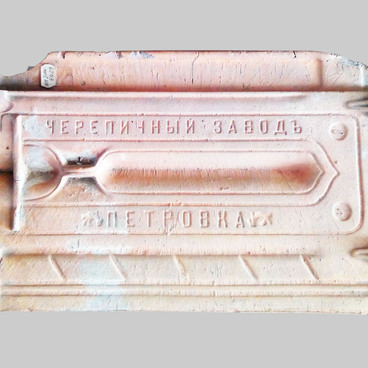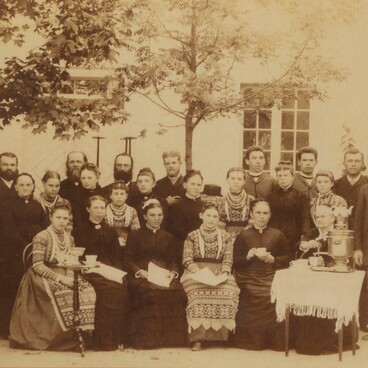Russians lived in Sarepta from the very beginning. The first German missionaries from Saxony, having reached the small frontier fortress of Tsaritsyn, were provided by the commandant with several Russian soldiers and officers for protection.
Then the colonists hired Russian carpenters to build the first wooden houses and barracks. Soon, factories, plants, manufactories began to open in Sarepta. Fields were laid out and sown, vineyards, orchards, vegetable gardens and melons were planted. Russian people tried to get any job in the city - a shepherd, a watchman, a plowman, a harvest collector, an auxiliary worker.
About a hundred Orthodox workers with their families already lived in the colony and an Orthodox church was built at the Sarepta railway station at the beginning of the 20th century. The garmon was a favorite instrument of the Russian inhabitants of Sarepta and sounded at holidays and festivities.
Garmon (or accordion) is a keyboard-pneumatic musical instrument belonged to squeezeboxes. There are two types of garmons. Some of them when pressing the same button change the sound in pitch depending on whether the bellows are stretched or compressed. On other accordions, the sound remains the same regardless of the movement of the bellows. Also accordions differ in the number of rows of buttons on the right keyboard - there are single-row, two-row and three-row accordions. The most common are two-row accordions.
There is no reliable information about the time and place of the invention of the squeezebox. According to one version, the first squeezebox (harmonica) was created by the Berlin master Christian Buschmann in 1822. According to another version, the instrument was first made by the Czech organ master Frantisek Kirchnik, who lived in St. Petersburg, back in 1783.
The design of all squeezeboxes includes two half-cases with keyboards and the air bellows between them. By moving the half-shells, the musician stretches and squeezes the bellows, forcing air through the metal tongues that create sound. The melody is played on the right keyboard and accompaniment is played on the left keyboard.
Many regional varieties of accordions have emerged in Russia: Saratov, Livenka, Tula, Vyatka, Vologda, Yelets and others. They differ in size, design features, timbre, sound strength. This instrument became widespread in Russia in the second half of the 19th century.
Since the 1920s, the khromka garmon has become the most popular. The khromka garmon is also presented in the museum’s exposition. It was created at the beginning of the 20th century by the Vologda master Nikolai Smyslov. This is a two-row diatonic accordion. The pitch of the sound produced by this instrument does not depend on the direction of movement of the bellows. This makes the khromka similar to the chromatic button accordion - hence it got its name.
Then the colonists hired Russian carpenters to build the first wooden houses and barracks. Soon, factories, plants, manufactories began to open in Sarepta. Fields were laid out and sown, vineyards, orchards, vegetable gardens and melons were planted. Russian people tried to get any job in the city - a shepherd, a watchman, a plowman, a harvest collector, an auxiliary worker.
About a hundred Orthodox workers with their families already lived in the colony and an Orthodox church was built at the Sarepta railway station at the beginning of the 20th century. The garmon was a favorite instrument of the Russian inhabitants of Sarepta and sounded at holidays and festivities.
Garmon (or accordion) is a keyboard-pneumatic musical instrument belonged to squeezeboxes. There are two types of garmons. Some of them when pressing the same button change the sound in pitch depending on whether the bellows are stretched or compressed. On other accordions, the sound remains the same regardless of the movement of the bellows. Also accordions differ in the number of rows of buttons on the right keyboard - there are single-row, two-row and three-row accordions. The most common are two-row accordions.
There is no reliable information about the time and place of the invention of the squeezebox. According to one version, the first squeezebox (harmonica) was created by the Berlin master Christian Buschmann in 1822. According to another version, the instrument was first made by the Czech organ master Frantisek Kirchnik, who lived in St. Petersburg, back in 1783.
The design of all squeezeboxes includes two half-cases with keyboards and the air bellows between them. By moving the half-shells, the musician stretches and squeezes the bellows, forcing air through the metal tongues that create sound. The melody is played on the right keyboard and accompaniment is played on the left keyboard.
Many regional varieties of accordions have emerged in Russia: Saratov, Livenka, Tula, Vyatka, Vologda, Yelets and others. They differ in size, design features, timbre, sound strength. This instrument became widespread in Russia in the second half of the 19th century.
Since the 1920s, the khromka garmon has become the most popular. The khromka garmon is also presented in the museum’s exposition. It was created at the beginning of the 20th century by the Vologda master Nikolai Smyslov. This is a two-row diatonic accordion. The pitch of the sound produced by this instrument does not depend on the direction of movement of the bellows. This makes the khromka similar to the chromatic button accordion - hence it got its name.



